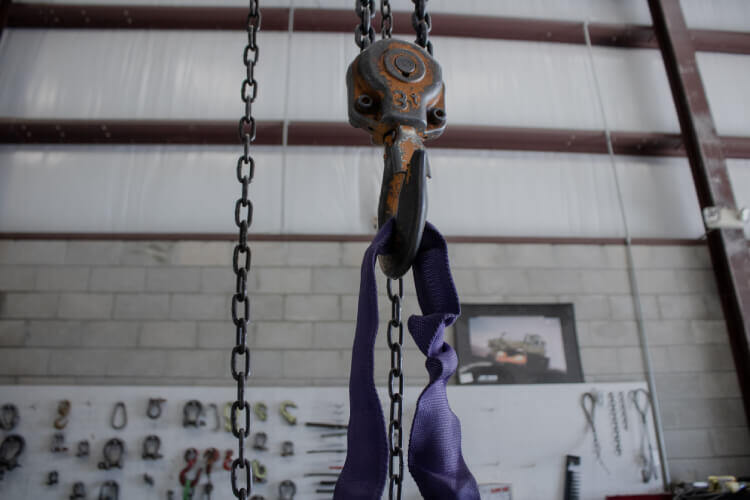
So how do I become a rigger?
After completing both CICB’s Mobile Crane Operator Training and CCO Mobile Crane Operator Prep courses, I took the Class C Rigger course to focus on learning rigging.
When I entered the course, my only rigging knowledge was from the mobile crane operator courses- my experience in this field was essentially none. The course lasts two days and covers the fundamentals of rigging.
Similar to the mobile crane courses, CICB provides you with a textbook that is yours to keep. There are practice questions in the book to test your understanding of the course.
Unlike the mobile crane courses, which last five days, the Class C Rigger course is only two days.
My instructor for this course was Trent, and he often related content to his previous work experience with rigging, which makes the information easier to comprehend for anyone who wants to become a rigger.
He divided our class into two specific sections: inspections and rigging practice.
Day One: Learning Rigging Inspection
The first day began with taking a pre-test, to see what rigging knowledge we brought to the class. For those who want to become a rigger but are starting from the beginning, this may not be much at all.
After completing the assessment, we went over each answer in detail. This helped us learn about the different types of rigging equipment.
We did not only learn about the equipment; we also learned how to inspect them. Although this is not an inspection course, you must inspect equipment prior to each use. Knowing when to take equipment out of service is important for preventing injuries and even deaths.
While learning this information, Trent demonstrated correct and incorrect procedures for handling equipment. In the workplace, bad habits often form, which can cause safety issues. It is important to understand and utilize rigging practices to the OSHA and ASME/ANSI standards.
Although today did not consist of hands-on experience, there were several videos and demonstrations shown. We learned how quickly a sling’s capacity can decrease, and what we can do to avoid breaking one. The videos and demonstrations were a nice break from the textbook, as we had a visual to complement the textual information.
One surprise for me during this class was the level of math involved for anyone who wants to become a rigger. Basic geometry is used, which is something I have not seen since high school. Trent clearly explained the Pythagorean Theorem, which is helpful to determine the Sling Angle Factor.
Day Two: Learning Rigging and Communications
The second and final day of the course consisted of hands-on rigging and signaling. My classmates and I were given an assignment: using any material in the shop, lift a metal frame evenly. We were given the weight of the metal frame, and no additional information.
After several attempts and some pointers from Trent, our load finally lifted evenly. This exercise taught me how precise rigging can be. Just by spreading our hitches an extra inch apart, the weight distribution of the load completely changed.
Our rigging portion of the class ended halfway through the day. After lunch, we began the signal person portion of class. Signaling is just as important for anyone who wants to become a rigger as the two roles often go hand-in-hand on the jobsite.
After watching a video and practicing the hand motions, we put on our hard hats and walked outside to the Swing Cab Crane.
Trent operated the crane, while my classmates and I took turns signaling to him. Our goal was to guide him to the barrel, attach the barrel to the crane’s hook, and then lift, carry, and lower the load in the designated area.
I enjoyed this exercise and quickly picked up on the standard for signals. (You must signal “stop” after each movement, which took me a few times before the motions became fluid.)
Similar to rigging, it is important to use signals aligned to the standard. If your company has their own signals and works on a project with an outside operator, confusion may occur. The operator may misread a signal and move the load in the wrong direction. The standard signals are the universal language of the lifting industry.
We finished class with a written examination, which took the class about an hour to complete. After grading the test, Trent made sure we understood the questions we missed, and we cleared up any confusion. I left the class with knowledge of the fundamentals of rigging and signaling.
Should I Also Take This Rigging Course?
If you want to become a rigger, there are several entry points.
CICB’s Class C Rigger course has a written examination and a group practical. The certificate received for passing both exams allows your employer to deem you as a rigging assistant, rather than a qualified rigger.
The certificate can also be used (depending on the decision of your employer) in manufacturer testing facilities where one does not have to determine the proper rigging equipment for use.
Our Class B Rigger Course is similar to Class C, except there is a third day added to the course. The written and practical examinations will determine your understanding of selecting and applying rigging equipment. Your employer can use that certificate to designate you as a qualified rigger.
An alternative is our preparatory training for CCO Rigger Level I which will provide you with information to prepare for the CCO examination. Once you take and pass the CCO exam, you will receive a certification that can be transferred between employers.
To explore the difference between qualification and certification, you can see our article here.
If you have any questions regarding our Rigging Training courses, or want to find out more about how to become a rigger, please contact us at (800) 327-1386, or fill out our online contact form.






